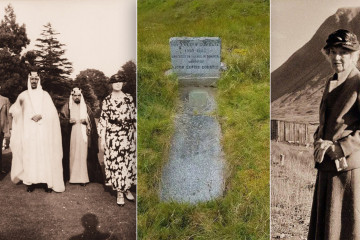

In Glen Carron estate, deep in the western Scottish Highlands, lies the final resting place of Lady Zainab Cobbold (born Lady Evelyn Murray) – the first British-born woman to perform the Hajj pilgrimage after converting to Islam.
Although causing a definite stir in the aristocrat's own lifetime, no one could have anticipated that her grave would become a shrine for Muslims decades after her death in January 1963.
The visitors begin their journey from a car park on the edge of the forest just off the A890 highway in Glen Carron. From there, they trek 10 kilometres up the slopes of Gleann Fhiodhaig, to a spot relatively far from her former home, which is the site Lady Zainab Cobbold is buried, according to the BBC's website.
Dozens of people gather every week to visit the Victorian aristocrat's grave, from Edinburgh, Liverpool, Leicester and beyond.
[Thread] It's Hajj season!
— A M A L I A H (@Amaliah_Tweets) July 14, 2021
Lady Zainab Cobbold, a convert, was the first documented British Muslim woman to perform Hajj.
This is a thread about her extraordinary journey to Islam 👇 pic.twitter.com/V9hjgqDkBK
Pilgrimage to Mecca
Public awareness of the contribution Lady Cobbold made to the understanding of Islam in the West had almost disappeared. However, public interest in her story was reignited a few years ago when her book Pilgrimage to Mecca was republished. The book, first published in 1934, documents Lady Zainab's physical and spiritual journey to the heart of the Islamic world.
Trips to visit the grave are being organised by the Convert Muslim Foundation – a UK-based charity which provides support to recent converts to Islam. It was set up by Batool Al Toma, an Irish citizen after she converted to Islam.
Al Toma says: "Ever since I heard about Lady Evelyn, I've been interested in her story, she was quite a formidable lady who never let herself be sidelined just because she was a woman."
"In Glen Carron estate, deep in the western Scottish highlands, lies the final resting place of Lady Zainab Cobbold – the first British-born woman to perform the Hajj pilgrimage after converting to Islam"
The visitors seem immune to the biting winds and blustery rain as they near their destination after a three-hour trek with just short resting breaks. They continue their journey on to the grave, led by a guide, and on their arrival, they pray together.
On the return trip, a mosque in Inverness extends an invitation to the pilgrims to come and share a meal. Here, they are given a chance to reflect on the journey they have taken.
Immersed in Islamic culture from an early age
Lady Evelyn Cobbold was born in Edinburgh on 17 July 1867. She was the oldest child of Charles Adolphus Murray, 7th Earl of Dunmore and Lady Gertrude Coke, the daughter of Thomas Coke, 2nd Earl of Leicester. Her father was an avid traveller, and when he moved to North Africa, his family accompanied him. It was there that Lady Cobbold became acquainted with Islam; the family's servants, who she was surrounded by as she grew up, were all either Egyptian or Algerian.
In 1912, Lady Zainab published the book A Wayfarer in the Libyan Desert. While this was before her conversion to Islam, it was clear that her transformative experiences growing up in North Africa and her abiding interest in the region had become a way of life.
The Inverness Masjid (mosque) website states: "Lady Evelyn's Muslim faith – as the Scots-born daughter of a British aristocratic family – was nevertheless quite remarkable, not least in an era when Islam possessed a somewhat exotic reputation within British society.
The day Lady Zainab converted to Islam, she made a commitment to perform Hajj.
— A M A L I A H (@Amaliah_Tweets) July 14, 2021
In 1929, she contacted the ambassador to the UK, of what is now known as Saudi Arabia, about her wish and she was granted permission to visit Mecca & complete Hajj by the King of Saudi Arabia. pic.twitter.com/bO8mOzJRbi
"Changing from being a Roman Catholic to a Protestant or a Protestant to a Roman Catholic, or even diverging from Christianity towards Buddhism – all these were comprehensible and had some precedent. But, to embrace Islam was something very different."
Dismissed by academia
According to the website, Angus Sladen, Lady Zainab's great-grandson, believes the lack of interest in her contribution to the West's understanding of Islam has a few reasons. These were that in British society she was considered to be eccentric, "and maybe a bit snobbish."
Additionally, he thinks the academic community in the United Kingdom didn't believe she was serious and just thought she was trying to cause a stir in her circles.
These assumptions were based on the reductionist view of these academics that categorised her in this way because she had not been well-educated in their view. They belittled her understanding of Islamic culture as being limited to what she had learned from her governesses.
This is an edited translation from our Arabic edition. To read the original article click here.
Translated by Rose Chacko
This article is taken from our Arabic sister publication, Al-Araby Al Jadeed and mirrors the source's original editorial guidelines and reporting policies. Any requests for correction or comment will be forwarded to the original authors and editors.
Have questions or comments? Email us at: info@alaraby.co.uk




 Follow the Middle East's top stories in English at The New Arab on Google News
Follow the Middle East's top stories in English at The New Arab on Google News


